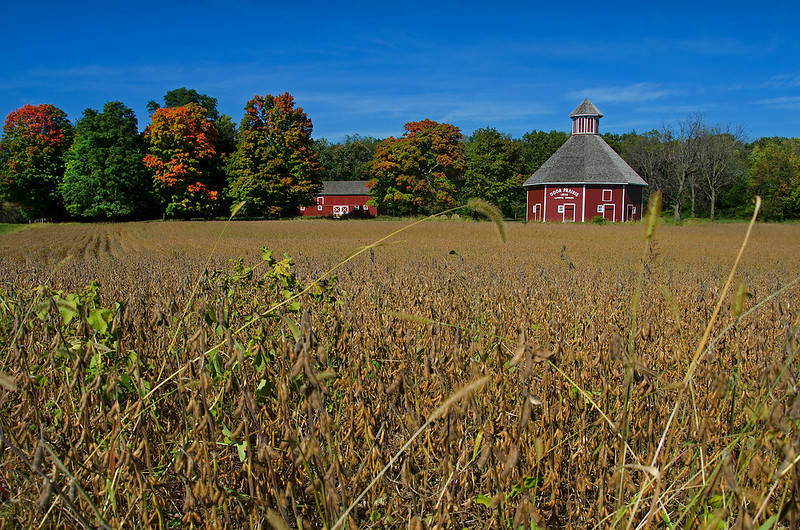 Welcoming those traveling north on U.S. 35 in northern Indiana, the Door Prairie barn is the unofficial boundary marker and greeter of the City of LaPorte. Built in 1882 to house horses and cattle, this unique nine-sided barn is perhaps the most unusual in the State of Indiana. Round barns are relatively common across the United States; Indiana has around 100, Fulton County, has seven surviving round barns - and an annual festival to celebrate them. "Round barns" are not all round, some are hexoganal, octagonal, or dodecagons. What makes the Door Prairie barn unusal is the odd number of sides. Why nine? We can't ask the builder John Jeffrey, he's no longer with us. But if we look to the original owner of the barn, Marion Ridgeway, we can draw a possible connection between the barn and his religious beliefs - he was a Quaker. The number nine in Christian belief, often represents perfection, and divine completion, and Christ often represents the number. Nine also represents the fruits of the Holy Spirit, which are Faithfulness, Gentleness, Goodness, Joy, Kindness, Long suffering, Love, Peace and Self-control (Galatians 5:22 - 23) --(biblestudy.org). Or, it may have less symbolic significance and purely structual importance. Perhaps aesthetics? Whatever the case may be, this landmark of LaPorte County welcomes me, and makes me feel at home every time I pass by.
Welcoming those traveling north on U.S. 35 in northern Indiana, the Door Prairie barn is the unofficial boundary marker and greeter of the City of LaPorte. Built in 1882 to house horses and cattle, this unique nine-sided barn is perhaps the most unusual in the State of Indiana. Round barns are relatively common across the United States; Indiana has around 100, Fulton County, has seven surviving round barns - and an annual festival to celebrate them. "Round barns" are not all round, some are hexoganal, octagonal, or dodecagons. What makes the Door Prairie barn unusal is the odd number of sides. Why nine? We can't ask the builder John Jeffrey, he's no longer with us. But if we look to the original owner of the barn, Marion Ridgeway, we can draw a possible connection between the barn and his religious beliefs - he was a Quaker. The number nine in Christian belief, often represents perfection, and divine completion, and Christ often represents the number. Nine also represents the fruits of the Holy Spirit, which are Faithfulness, Gentleness, Goodness, Joy, Kindness, Long suffering, Love, Peace and Self-control (Galatians 5:22 - 23) --(biblestudy.org). Or, it may have less symbolic significance and purely structual importance. Perhaps aesthetics? Whatever the case may be, this landmark of LaPorte County welcomes me, and makes me feel at home every time I pass by.
Fall at the Door Prairie Barn
 Welcoming those traveling north on U.S. 35 in northern Indiana, the Door Prairie barn is the unofficial boundary marker and greeter of the City of LaPorte. Built in 1882 to house horses and cattle, this unique nine-sided barn is perhaps the most unusual in the State of Indiana. Round barns are relatively common across the United States; Indiana has around 100, Fulton County, has seven surviving round barns - and an annual festival to celebrate them. "Round barns" are not all round, some are hexoganal, octagonal, or dodecagons. What makes the Door Prairie barn unusal is the odd number of sides. Why nine? We can't ask the builder John Jeffrey, he's no longer with us. But if we look to the original owner of the barn, Marion Ridgeway, we can draw a possible connection between the barn and his religious beliefs - he was a Quaker. The number nine in Christian belief, often represents perfection, and divine completion, and Christ often represents the number. Nine also represents the fruits of the Holy Spirit, which are Faithfulness, Gentleness, Goodness, Joy, Kindness, Long suffering, Love, Peace and Self-control (Galatians 5:22 - 23) --(biblestudy.org). Or, it may have less symbolic significance and purely structual importance. Perhaps aesthetics? Whatever the case may be, this landmark of LaPorte County welcomes me, and makes me feel at home every time I pass by.
Welcoming those traveling north on U.S. 35 in northern Indiana, the Door Prairie barn is the unofficial boundary marker and greeter of the City of LaPorte. Built in 1882 to house horses and cattle, this unique nine-sided barn is perhaps the most unusual in the State of Indiana. Round barns are relatively common across the United States; Indiana has around 100, Fulton County, has seven surviving round barns - and an annual festival to celebrate them. "Round barns" are not all round, some are hexoganal, octagonal, or dodecagons. What makes the Door Prairie barn unusal is the odd number of sides. Why nine? We can't ask the builder John Jeffrey, he's no longer with us. But if we look to the original owner of the barn, Marion Ridgeway, we can draw a possible connection between the barn and his religious beliefs - he was a Quaker. The number nine in Christian belief, often represents perfection, and divine completion, and Christ often represents the number. Nine also represents the fruits of the Holy Spirit, which are Faithfulness, Gentleness, Goodness, Joy, Kindness, Long suffering, Love, Peace and Self-control (Galatians 5:22 - 23) --(biblestudy.org). Or, it may have less symbolic significance and purely structual importance. Perhaps aesthetics? Whatever the case may be, this landmark of LaPorte County welcomes me, and makes me feel at home every time I pass by.
Blood Moon
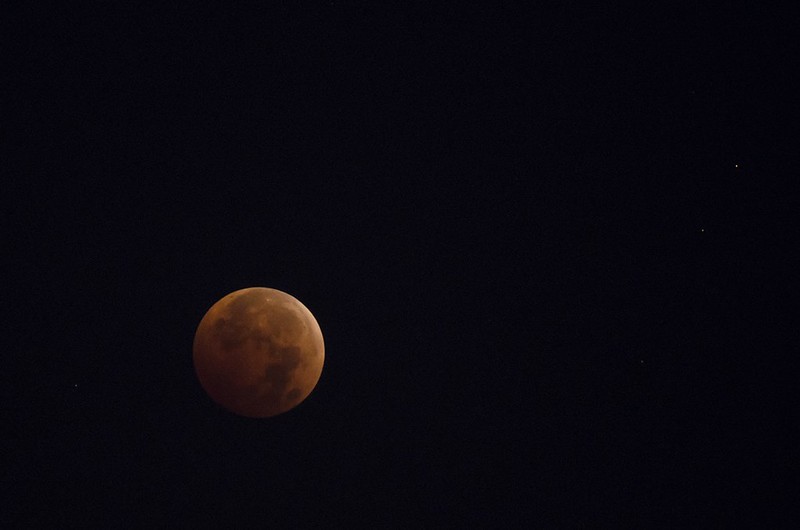
This morning's lunar eclipse was also considered a "blood moon." The term blood moon seems to date back to biblical times when it was described the moon will turn blood red before the end of time. The term was then used to describe a series of four, total lunar eclipses, with no partial eclipse in between, each separated by six full moons. -earthsky.org
in addition, Blood Moon today is used to describe a red colored moon - all total lunar eclipses turn the moon red due to the dispersion of light during the eclipse.
This morning's blood moon was also considered the Hunter's Moon - interesting.
From a Dune Perch
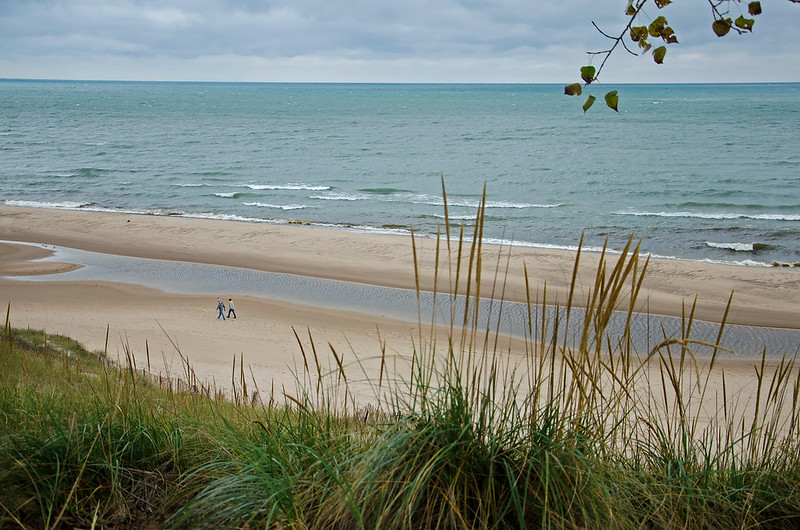
It's great to know that at least a few of the dunes on the Indiana shore of Lake Michigan are open to climb. Most are off limits, no foot traffic allowed, in an attempt to keep the dunes from eroding. Understandable in some cases- especially where the Marram Grass is not taking hold. However, in my experience, when an existing path (official or otherwise) is closed to foot traffic, ignorant people disregard the signs, and walk around them, eroding a far larger area than if the original path was kept open.
But the jury is still out on that matter; Lake Michigan itself seems to cause more damage to the dunes than human feet - just look at the aftermath of the last two storms that hit the area. Waves crashed into the foot of the dunes, causing massive erosion of the foredunes. A natural occurrence, and one not caused by feet. In fact, any damage or changes to the dunes done by human feet in the past century were washed away into the lake. Blame the Michigan City breakwater for starving these beaches of sand, not the wide-eyed child climbing a dune for the first time.
Closing most of the dunes from foot traffic seems excessive. Mt. Baldy was regulated a couple of years back, to keep people away from the areas of the dunes that were replanted with Marram Grass. Yet, intentional paths remained so visitors could experience the view from the top. Reasonably so, the remains completely closed after the near tragic cave-in back in July 2013, but there are few if any foredunes one can climb today without man-made stairs. Of course, indefinitely closing all of Mt. Baldy keeps people off of the Marram Grass - coincidence?
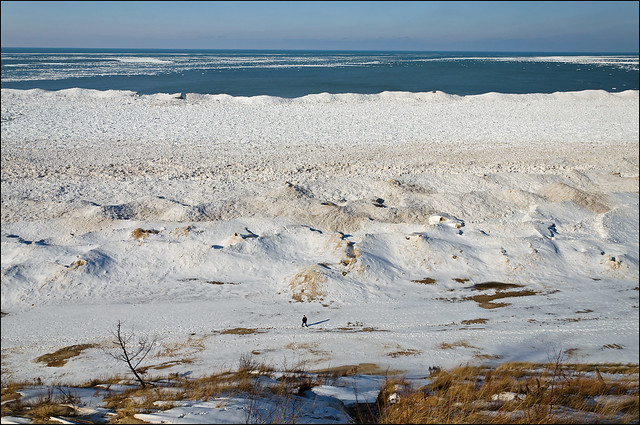
Fall is here, and soon many of the Indiana Dunes National Lakeshore beaches will close for winter. In past years, Mt. Baldy was open year-round, providing access to the frozen lakefront, and Central Beach allowed parking for two or three cars in front of the locked parking lot gate. These beaches in winter are amazing - words can't describe them. The shelf ice piles to heights of 15 feet or more, and stretch out hundreds, sometimes thousands of feet into the Lake. Yet, these two beaches are off limits in winter - what a blow to the visiting public. Anyone familiar with the area knows the ice is much different here than the few open park areas to the west.
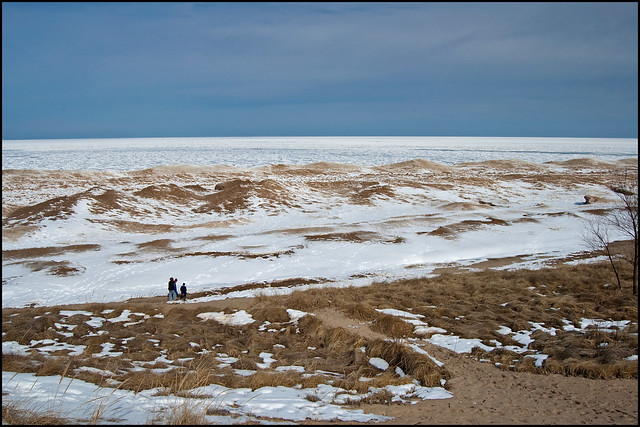
Because Mt. Baldy remains closed, I suggest the National Lakeshore consider allowing full or limited parking at Central Beach all winter, allowing visitors to access this winter treasure. Why not? Central Avenue is plowed to the parking lot anyway. Cost can't be much of an issue, especially if one takes into account Mt. Baldy in past years was open year-round, and is now closed. Why not allocate those resources for snowplowing, and washroom maintenance at Central Beach? If cost is a hindrance, then close the washrooms, but allow parking. At the very least, give the public the opportunity to view this area in winter.
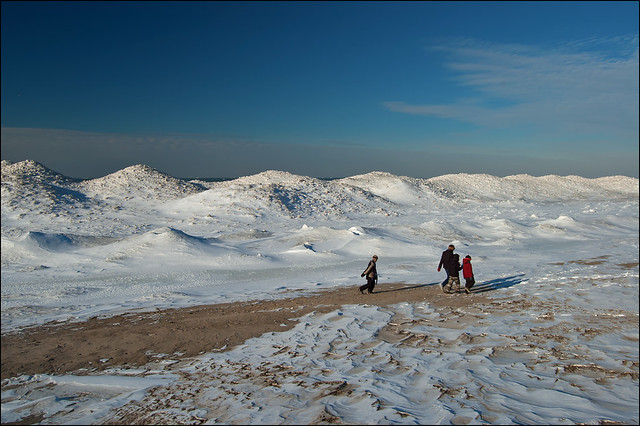
In this Internet era, I suppose one can visit the park virtually, Children can use their smartphones to view old photos taken by their grandparents who were lucky enough to walk on the dunes in winter. Is the goal to impede the dunes, or to protect the dunes? Closing these areas seems to point to the former.
Saturday Activity
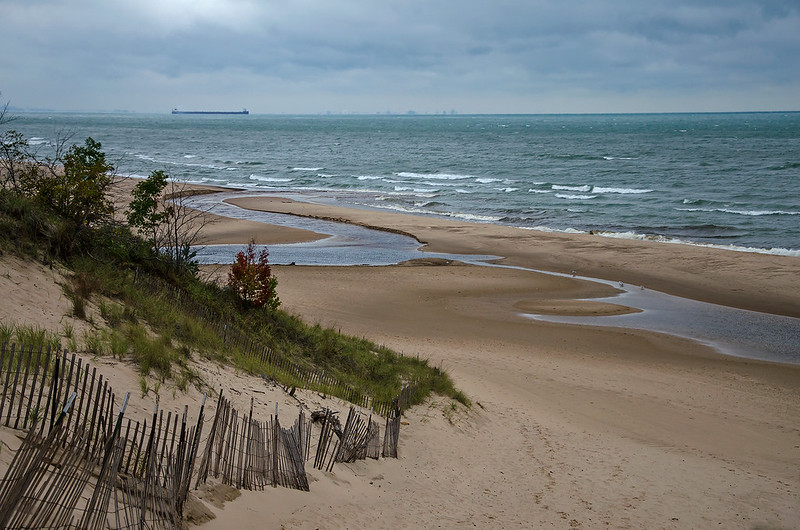 An unseasonably cold morning for October - 38 degrees, with winds, rain, and yes, even snow flurries - made for a chilly walk on the beach. Not one to shy away from inclement weather, I find these days among the best for visiting the shore; I'm usually alone. This morning was a bit different. Not counting the five or six people I saw braving the weather, there was plenty of activity along the shore of Lake Michigan. Beyond the gulls, a small stream made it's way to the lake, relentlessly cutting through the sand piled up by the surf; it's path changing with every wave. Riding the high waves in the distance is a container ship leaving the Port of Indiana, heading to a port unknown to those watching from the shore. On much of the horizon, the industry of the south side of Chicago can be seen through the light fog and drizzle. Even the wood fence seems to head toward the lake.
An unseasonably cold morning for October - 38 degrees, with winds, rain, and yes, even snow flurries - made for a chilly walk on the beach. Not one to shy away from inclement weather, I find these days among the best for visiting the shore; I'm usually alone. This morning was a bit different. Not counting the five or six people I saw braving the weather, there was plenty of activity along the shore of Lake Michigan. Beyond the gulls, a small stream made it's way to the lake, relentlessly cutting through the sand piled up by the surf; it's path changing with every wave. Riding the high waves in the distance is a container ship leaving the Port of Indiana, heading to a port unknown to those watching from the shore. On much of the horizon, the industry of the south side of Chicago can be seen through the light fog and drizzle. Even the wood fence seems to head toward the lake.
The Gourd Hoard

It seems the stranger the shape, the more popular they are. Gourds are a sure sign that Fall is here, as much as I hate to admit it. Every farmer's market, pumpkin patch, and store with Fall decorations has a variety of ornamental gourds, and most people purchase them stricktly for decoration. As it turns out, most of the ornamental gourds are edible - not that I'm particularly interested in trying them. Properly ripened, and washed gourds can be cooked and eaten - who knew?!
Most gourds are purchased in the Fall, then set out for display until they either rot, or are taken down for Christmas decorations. If you find particular ones you'd love to keep, you can dry them and keep them for years to come.
Wash the gourds with soap and water, and rinse them with some liquid disinfectant. Carefully towel dry them. Place them in a warm, dry location, on an absorbant surface such as paper for about a week to dry.
Wipe the gourds once more with some disinfectant, and spread them on fresh paper in a warm, dry, dark location for about four weeks. After this drying period, they're ready to keep for years. You can leave them as they are, cover them in clear shellac, or paint designs on them.
Capricious
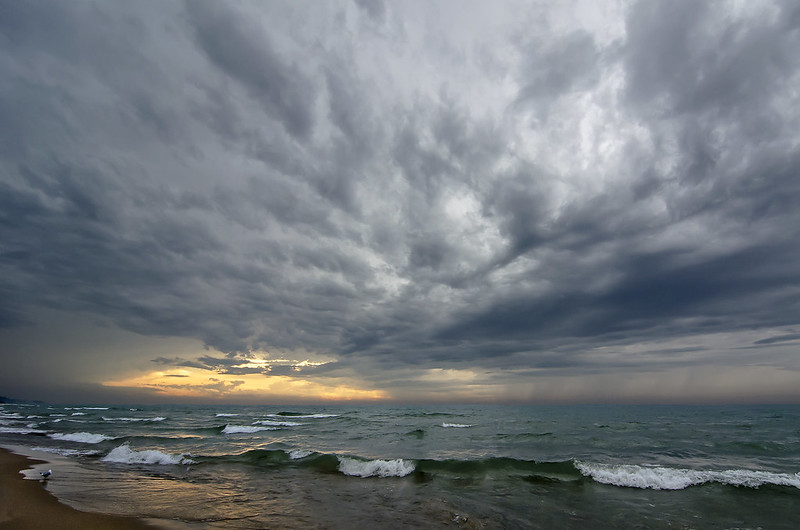
From sun to rain, and everything in between - that's what we experienced while walking the beach at St. Joseph, Michigan. One moment the sun was shining, the next it was raining. It didn't force us to alter our plans, we still enjoyed the beach. In fact, the changing weather made for some great interest in the sky.
Once a few raindrops fell, almost all the beachgoers fled, and we had the beach pretty much to ourselves. Rain showers only lasted a few minutes at a time, with plenty of rainless periods in between.
It was odd, however, to see our footprints in the wet sand - they were completely dry. quite the opposite of walking on pavement, the wet sand stuck to our feet, and revealed dry sand underneath.
Dam Ruins
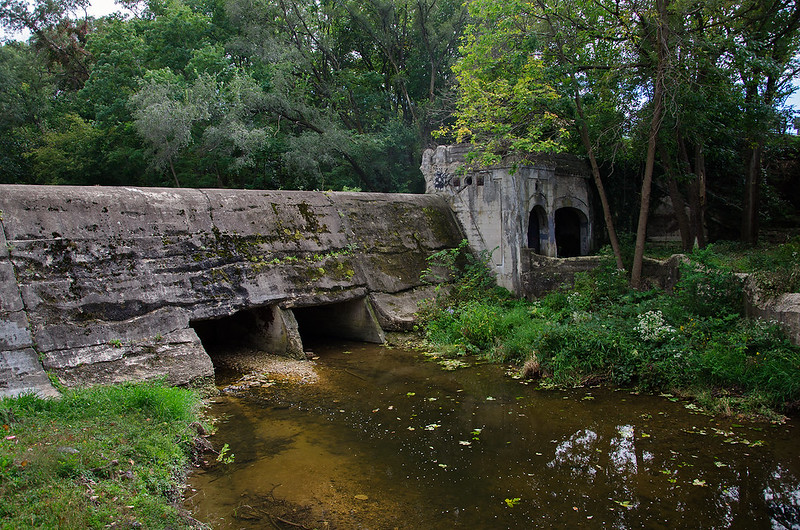 The ruins of a small dam located in Dellwood Park, in the town of Lockport, Illinois. The park was built in 1905 by the Chicago and Joliet Electric Railway Company to gain ridership on the small line. Two dams were built on the small creek that runs through the small limestone canyon to create deeper water for recreation. A boat house, dancing pavilion, and other amenities were constructed, making Dellwood Park one of the most picturesque parks in the area. The railroad was used to transport visitors to and from the park on weekends - thousands picnicked on the grounds, and rowed boats in the man-made lagoons each weekend. The dams are still visible today, but no longer hold water.
The ruins of a small dam located in Dellwood Park, in the town of Lockport, Illinois. The park was built in 1905 by the Chicago and Joliet Electric Railway Company to gain ridership on the small line. Two dams were built on the small creek that runs through the small limestone canyon to create deeper water for recreation. A boat house, dancing pavilion, and other amenities were constructed, making Dellwood Park one of the most picturesque parks in the area. The railroad was used to transport visitors to and from the park on weekends - thousands picnicked on the grounds, and rowed boats in the man-made lagoons each weekend. The dams are still visible today, but no longer hold water.
Sunset Mirage
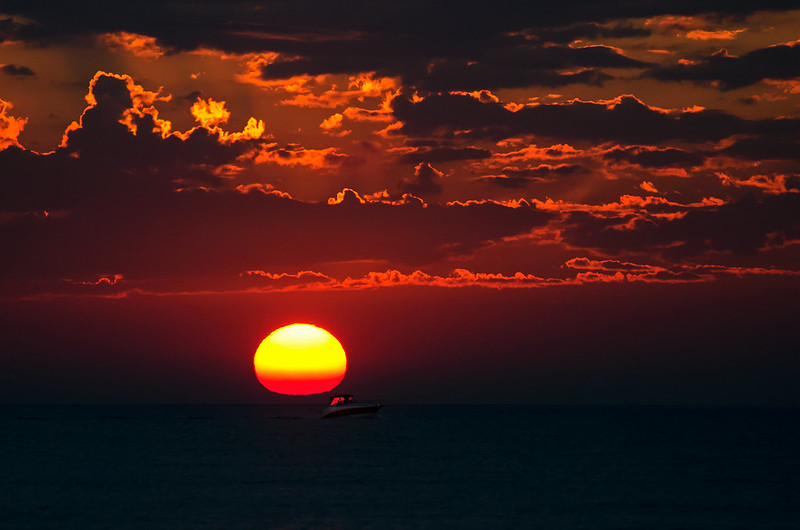
A boat heads for home as the sun sets over Lake Michigan. On the last weekend of Summer, rain showers interrupted much of the day, yet as if on queue, the sky cleared for sunset. As we watched the sun dip below the horizon for the last time this summer, I noticed the usual bands of red, yellow, and white appear on the photos I captured. Adusting the shutter speed to bring out the intense reds in the clouds, only brought out more of the bands in the sun. Just as the moon appears larger and more colorful when it's lower in the sky, the sun also appears to change at sunset. When the moon or sun is low in the sky, the light emitted from them must travel through more of the earth's atmosphere. The atmosphere is different temperatures at different levels, so the light is distorted a bit at each level, creating a mirage that changes the shape and color of the sun as it sets. That's why the solar disk is flattened and has different bands of color.
Summer's Last Breath
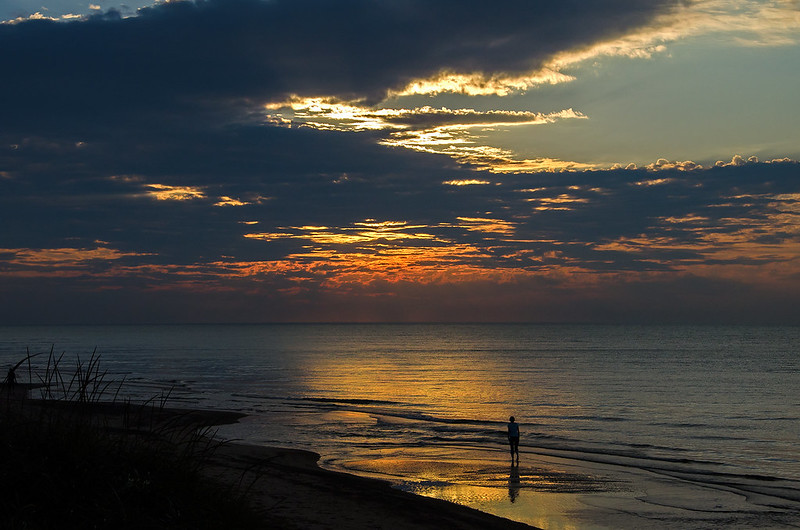
Following a day of showers, the sun illuminated the few remaining clouds left in the sky as evening approached. Almost giving up on a walk on the beach, we turned back after the last raindrops fell, and arrived a few minutes before sunset.
The sun did make an appearance, and we were able to watch the full solar disk disappear below Lake Michigan for the last time this summer. We'll continue to visit the beach throughout the Fall and Winter, but summer sunsets hold a special place in our souls.
This was like watching a good friend drive away after a long summer vacation. We'll stay in touch, but things won't be the same until we meet again next summer.
Heavy Surf
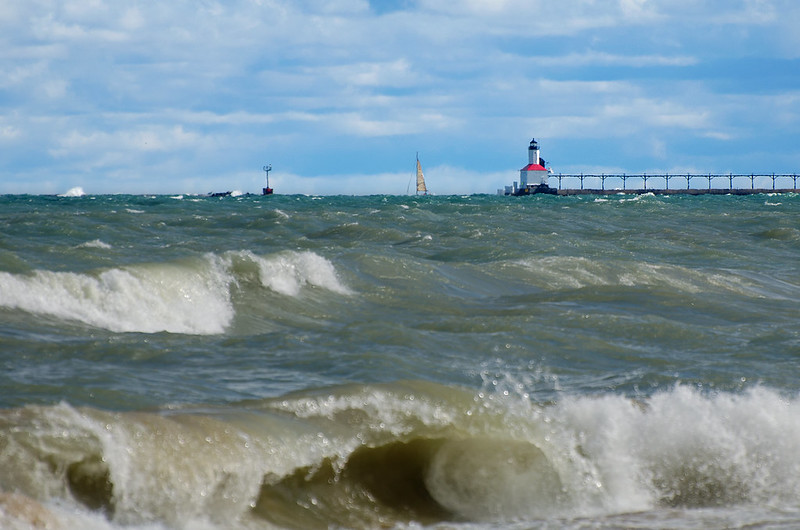
Standing guard in heavy surf, the Michigan City, Indiana East Pierhead lighthouse acts as a beacon for the sailboats and kitesurfers who dared to enter the water on such a windy day.
Known as an inland sea, Lake Michigan covers over 22,400 square miles -large enough for ocean going vessels, and considered just as dangerous as the ocean when it comes to waves. On this day, the waves were only about 4 to 7 feet high, but their frequency seems greater than that of most oceans. Still, sailboats and kite surfers were not deterred; with a lot of skill, and a little luck, all returned to shore safely.
Clouds and Whitecaps
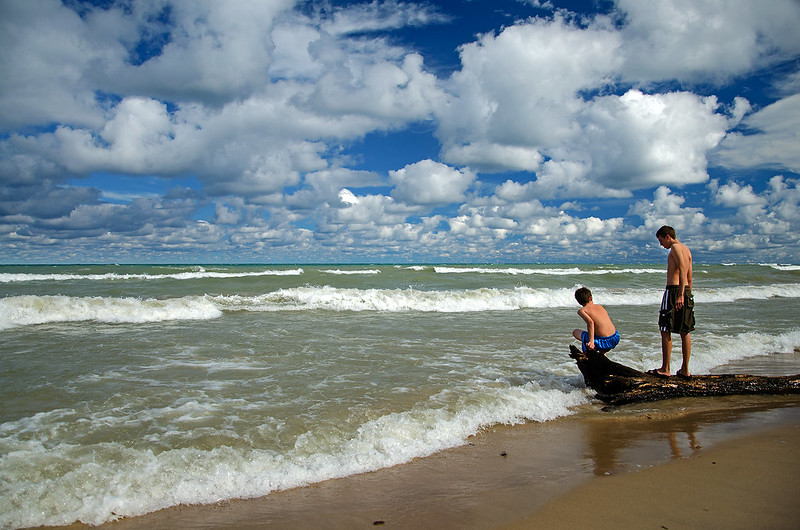
Still warm enough to enjoy the outdoors, the boys climb on a log that washed up on the beach. The waves were strong enough to move the log as they stood on it, making for some fun "surfing." Lake Michigan water temperatures were probably in the low 60s or high 50s, so getting splashed by the waves wasn't comfortable, but it was exciting.

It seems right after Labor Day, the temperatures drop enough for it to feel like Fall, and the winds begin to churn up the lake. When the winds come from the northwest, the clouds seem to hang right over the lake, like a cotton ceiling; almost endless.
Touching the Dunes
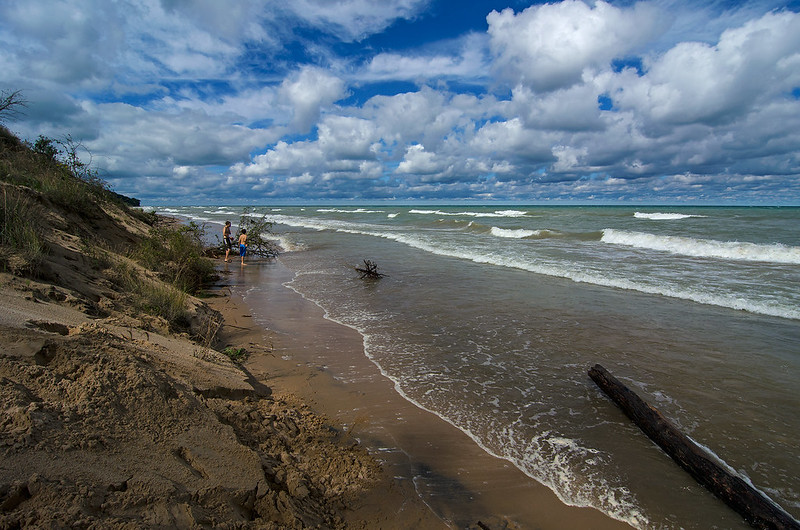
High winds kicked up Lake Michigan, and drove the surf far onto the beach - up to the sand dunes. Visitors on this cool weekend were forced to walk in the waves, as the beach all but disappeared due to the high water.
Waves crashed into the dunes, causing some erosion and small slides, as the sand washed into Lake Michigan. Walking along the beach was challenging; we couldn't walk on the dunes because they're protected - people's footprints will erode them. Seems Lake Michigan was doing a pretty good job of eroding the dunes without the help of visitor's feet.
This natural process happens time and time again, regardless if man is present. He is a witness.
Patterns
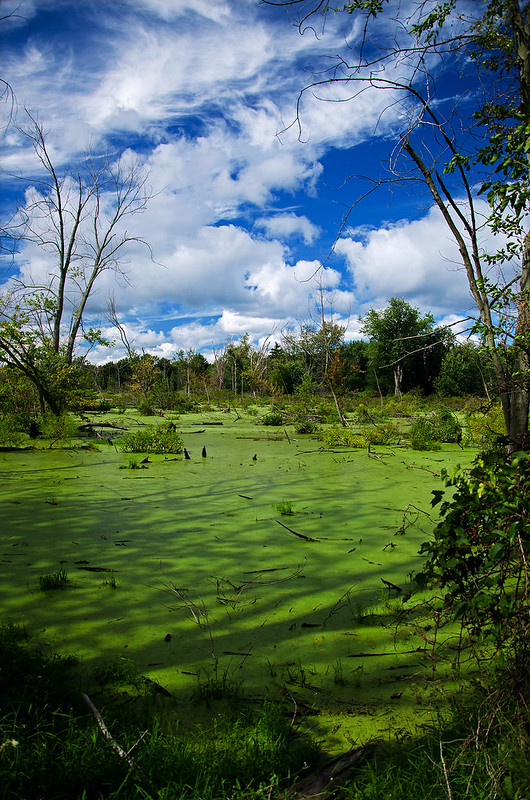
Plenty of duckweed, fallen trees, stumps, water birds, and shadows - all the makings of an interesting swamp. This week, we decided to take a short hike from Central Beach to the swamp, to see what was new in this wetland.
Most visitors to the Indiana Dunes National Lakeshore, generally stop at the beach; they're not aware of the other interesting places to see in the park. Woods, forests, grasslands, bogs, farms, are all part of the park, and I think just as interesting and beautiful as the lakeshore.
As we drive to different places in the park, we pass this swamp, and each time I notice the changes that occurred since our last visit. Following a storm, there are new fallen trees; during a dry period, the water often dries up. Most changes, however, are so subtle, that visitors won't take notice of them as they head to the beach. The wildlife changes as well. Frogs are among the first creatures to make an appearance in the Spring, followed by sightings of turtles, blackbirds, then waterbirds migrating from the south. Snakes and lizards can be seen in early summer, along with mosquitoes and biting flies.
As the Summer winds down, we'll experience the more obvious changes of Fall. As the leaves turn color and drop, many of the animals will hibernate or head south before the lush green turns to fluffy white.
Beach Goers
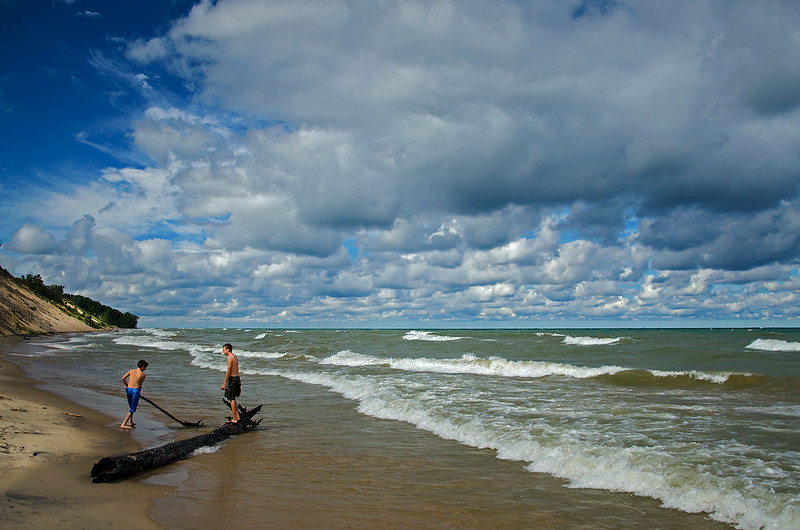 It seems every year, right after Labor Day, everything takes on a different look. The clouds and sky seem more vivid, the sun all of a sudden moves to a drastically different angle, and the days seem cooler and windy. I'm sure it has a lot to do with Fall approaching, and perhaps Labor Day simply provides a point of reference where we begin to notice these changes that have taken place for weeks prior. With early morning temperatures in the low 60's, and winds howling across Lake Michigan, we still set out in shorts and short sleeves to explore the beaches of the Indiana Dunes National Lakeshore. Nothing unusual there - we visit in January too! After a walk along the shore, the sun warmed things up, and we took to the water. The winds were whipping up the lake, creating some high waves, and pushing the water onto the beach, up to the dunes in some places. We witnessed the collapse of small portions of the dunes as the waves hit - something natural, and not due to people walking on them as the park service might seem to indicate with the closing of the paths on most every dune in Indiana. Due to man? Maybe; the construction of the Michigan City pier generations ago has starved these beaches of sand. Many people have closed up their summer cabins, taken their boats out of the water, and no longer think about visiting the beach, but we're still in summer mode, enjoying the sun, sand, and surf.
It seems every year, right after Labor Day, everything takes on a different look. The clouds and sky seem more vivid, the sun all of a sudden moves to a drastically different angle, and the days seem cooler and windy. I'm sure it has a lot to do with Fall approaching, and perhaps Labor Day simply provides a point of reference where we begin to notice these changes that have taken place for weeks prior. With early morning temperatures in the low 60's, and winds howling across Lake Michigan, we still set out in shorts and short sleeves to explore the beaches of the Indiana Dunes National Lakeshore. Nothing unusual there - we visit in January too! After a walk along the shore, the sun warmed things up, and we took to the water. The winds were whipping up the lake, creating some high waves, and pushing the water onto the beach, up to the dunes in some places. We witnessed the collapse of small portions of the dunes as the waves hit - something natural, and not due to people walking on them as the park service might seem to indicate with the closing of the paths on most every dune in Indiana. Due to man? Maybe; the construction of the Michigan City pier generations ago has starved these beaches of sand. Many people have closed up their summer cabins, taken their boats out of the water, and no longer think about visiting the beach, but we're still in summer mode, enjoying the sun, sand, and surf.
Exploring the Marsh
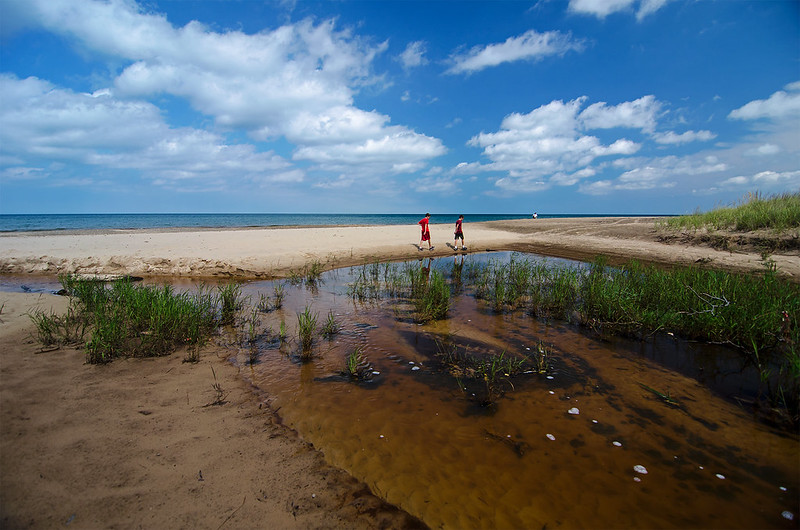 There are plenty of small streams the cut through the dunes and empty into Lake Michigan, and we manage to find most of them! This particular one formed a small marsh just before it entered Lake Michigan, making it a fun area for the boys to explore. Probably due to the beachgoers, not many creatures were hanging around the marsh on this morning, but we did come across plenty of dragonflies. Soon, the weather will begin to turn cold, and crossing these small streams will not be as easy - at least, not as comfortable - as it is in the summer months.
There are plenty of small streams the cut through the dunes and empty into Lake Michigan, and we manage to find most of them! This particular one formed a small marsh just before it entered Lake Michigan, making it a fun area for the boys to explore. Probably due to the beachgoers, not many creatures were hanging around the marsh on this morning, but we did come across plenty of dragonflies. Soon, the weather will begin to turn cold, and crossing these small streams will not be as easy - at least, not as comfortable - as it is in the summer months.
Sunset Plunge
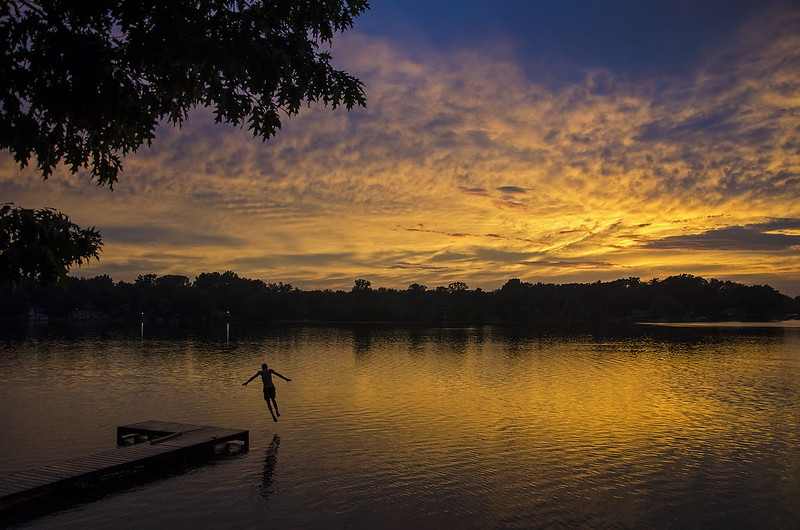 Taking advantage of the last weekend before school, the boys swam in the lake until dark. Nothing unusual for them - they tend to swim all day anyway, but this week seemed different. The weather turned rainy during dinner, but cooperated and stopped in time for them to enjoy the lake for a few more hours. Sunset itself wasn't too spectacular, but as the sun dropped below the horizon, the clouds broke up and displayed some beautiful golden colors against the dark blue sky. I've found this to be the case numerous times when disappointed by the sunset, stick around for 30 minutes, sometimes the sky is more amazing after sunset. With any luck, we'll repeat this scene a few times during the next few weeks.
Taking advantage of the last weekend before school, the boys swam in the lake until dark. Nothing unusual for them - they tend to swim all day anyway, but this week seemed different. The weather turned rainy during dinner, but cooperated and stopped in time for them to enjoy the lake for a few more hours. Sunset itself wasn't too spectacular, but as the sun dropped below the horizon, the clouds broke up and displayed some beautiful golden colors against the dark blue sky. I've found this to be the case numerous times when disappointed by the sunset, stick around for 30 minutes, sometimes the sky is more amazing after sunset. With any luck, we'll repeat this scene a few times during the next few weeks.
Just Past the Golden Hour
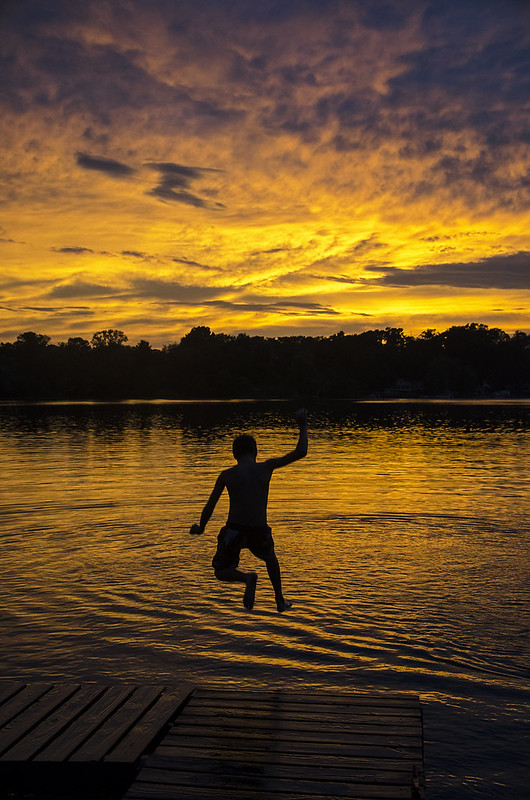
It's said that one of the best times for photography is the "golden hour," an hour just before sunset. I've found this to be true, but I've also found that the minutes just after sunset can create striking images as well. Using the golden hour, generally the sun is behind the camera, illuminating the subject in golden light. This image was shot into the light created by a colorful sunset after a storm moved through the area. No color enhancing in this image, they sky was on fire. The fun certainly doesn't end at sunset. The boys enjoyed a summer day swimming in the lake until a storm rolled in at dinner time. After a meal and dessert the rain ended, allowing them to get back in the water until dark. School is in session again, but summer isn't over yet.
Wetland from the Dune Ridge
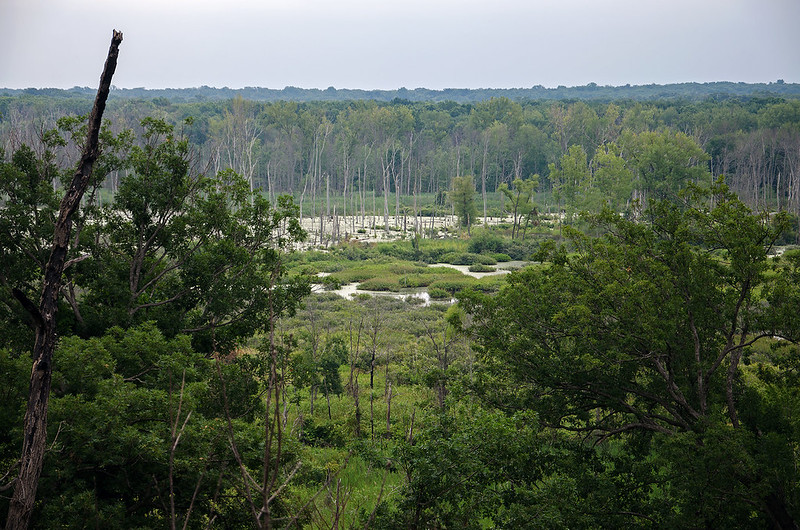
An easy hike up from the trail head on a normal day, this turned into a workout in the heat and humidity. No complaints here.
3/4 of the way to the ridge, we were greeted by several Cicada Killer wasps - huge wasps that hunt cicadas in mid flight, then return with them to their burrows to feed their larvae. They're quite intimidating, but if you realize the ones that seem to fly at you are male and have no stinger, you allow them to fly toward you. The larger female can sting, but is timid, and usually won't bother. They're about the size of an adult's thumb.
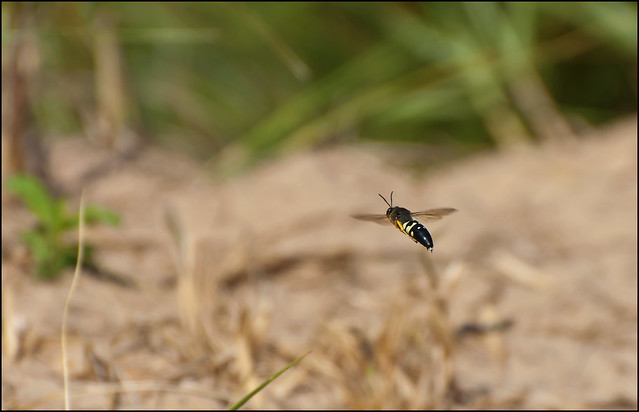
After several minutes watching the wasps battle for territory, we headed up to the ridge of the dune for a great view of the wetlands below. In summer, the view is mostly shielded by green leaves, but in winter when the leaves are gone, you have a wider view of the area.
Also found along this trail are six lined racerunner lizards - in fact, at times you can see half a dozen in a few yards. These lizards are found in many locations within the Indiana Dunes National Lakeshore.
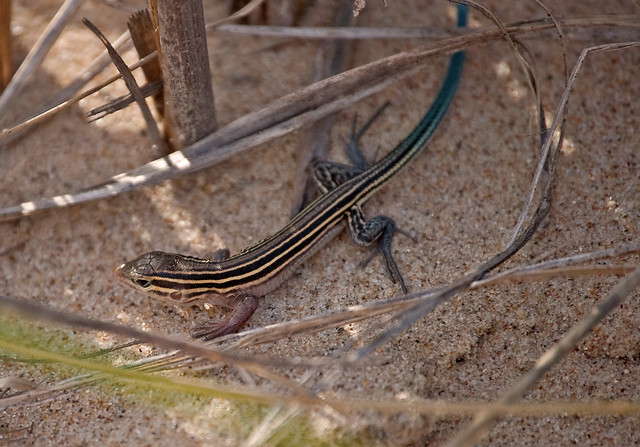
Peaceful Now
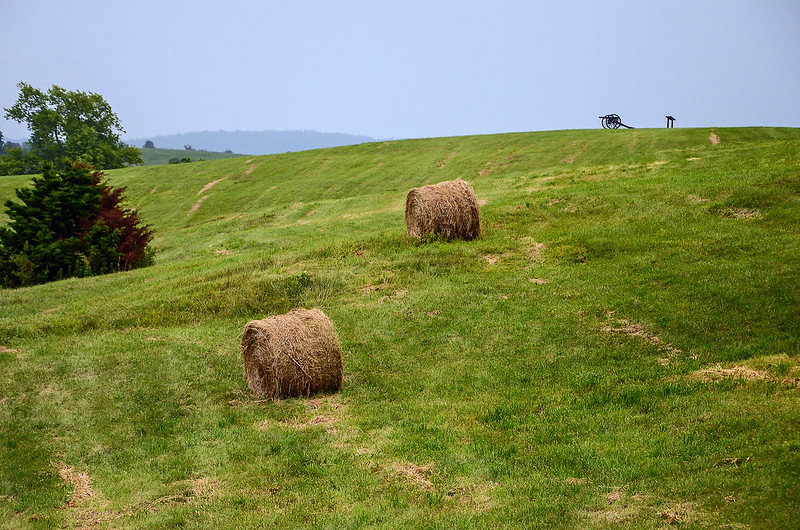
The battlefield where Confederate General Bragg completed his "Kentucky Invasion" is now quiet. On this site in October 8, 1862, 1,355 men were killed, and over 5,000 were injured fighting for control over this piece of land.
It's difficult to walk through this rolling countryside without sensing the battle that took place here. The thousands killed and injured, the artillary pounding the front line, the chaos, and the incredible noise.
Peaceful now.
Shady Acres
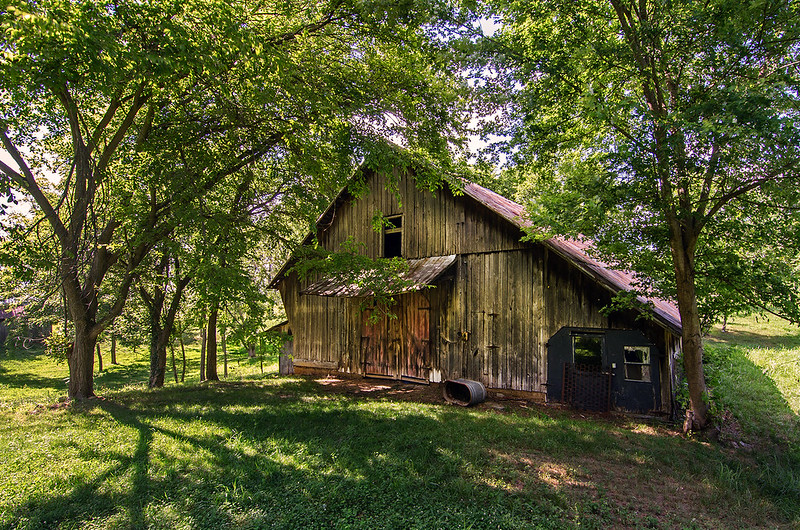
On our visit to Munfordville, I stopped to walk around a rustic barn on the Anthony Woodson Farm. Like hundreds of other barns I've seen in the countryside, this one is still structurally sound, but the weathered siding hints at its age.
The short time on this farm made me think of all the barns once utilized in this part of Kentucky - especially tobacco barns. I remember just 25 or 30 years ago, seeing field after field of tobacco on my drive to Mammoth Cave, each had a rustic tobacco barn on the property. Now, I struggle to find a single tobacco field in this area.
The barns in the midsection of the country are slowly fading away, and crumbling - no longer needed, or replaced by uninteresting steel-sided boxes.
Subscribe to:
Posts (Atom)

